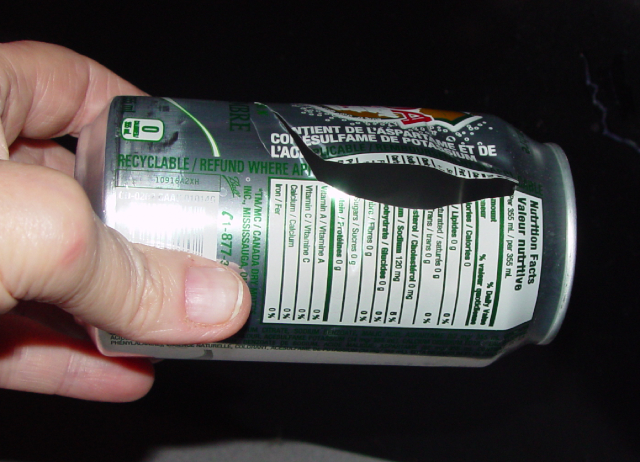I was minding my own business, researching a topic for a blog entry the other day, when I reached into the fridge for a can of Diet Ginger Ale. As soon as I laid my hand on it and started to lift… It exploded through a huge gash in its side, soaking me, my fridge and the floor…
 A big, fiendish, evil grin: The rent left in the ginger ale can by the big blow-out…
A big, fiendish, evil grin: The rent left in the ginger ale can by the big blow-out…
Almost 3 years ago (January, 2019), I wrote a post about how aluminum beverage cans were getting thinner and thinner – paper-thin would not be an exaggeration. The result was an unstable container that was prone to failure. I wrote it as a ‘letter to the Store Manager’, which read in part:
“I purchased four cases of [your store brand] Diet Ginger Ale at your market yesterday and was shocked to find that 3 of the 48 cans were pin-holed and spewed product all over the place when they were removed from the cardboard cases. A fourth had a larger triangular puncture in the side wall and had ‘bled’ out entirely in the case, mucking up the rest of the contents.”
It’s getting demonstrably worse
It was explained to me by a container manufacturing engineer that the standard beverage can has been painstakingly designed to hold its contents (be it beer, soda or sparking water) under considerable pressure from carbonation. In fact, the can as we currently know it is claimed by the engineers to be stronger full than it is empty. Try this, the engineer said: Squeeze a full, unopened can and see how firm it feels. Now, squeeze a full, opened can. Then squeeze an empty can. The can feels progressively flimsier and flimsier. The final squeeze tells the tale…
Remember the beverage can shortage?
It was billed as The Great Beer Can Drought of Summer 2020. But it affected supplies of all beverages that come in the standard aluminum can. The thing was, beer is not also sold in plastic bottles, like most soft drinks. So, soda and water fans really didn’t feel a pinch. But beer lovers sure did.
I devoted a post to the issue, pointing out the apparent cause: Demand for cans by beverage makers was at an all-time high, because legions of drinkers were buying millions of servings of beer and other drinks in cans, for consumption. With restaurants and bars closed due to COVID-19, millions of pints were not being poured as draft beer and foiuntain sodas in those venues – normally a major channel for beverage sales.
And some folks claimed that home-bound consumers were not recycling as many beverage cans as would usually be generated from restos and other ‘public’ sources – at least not enough to meet the exploding demand.
A matter of timing
I look at the timing of the can shortage versus the timing of the first round of leaky cans that I encountered. I am not a conspiracy theorist, by any means. But did the can makers start making thinner cans, squeezing more cans out of every kilogram / 2.2 lb. of raw aluminum, at the same time?
I have been told so many times through my life that ‘it’s nothing personal’ and ‘it’s just business’, and that is supposed to justify all sorts of shady, dangerous and just generally unsavoury activities and decisions.
And I can attest that it gets VERY personal when a can of Ginger Ale blows up in one’s face.
UPDATE!
As I was writing this post, sister Erin opened a new case of the same brand of ginger ale and pulled out a can… With a pinhole perforation in it, spraying soda everywhere! The plot thickens…
~ Maggie J.
